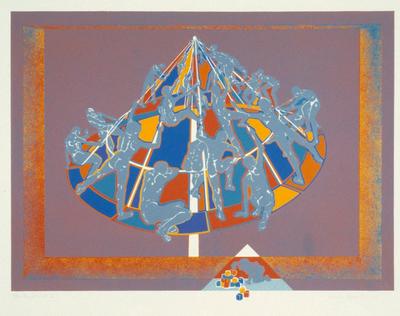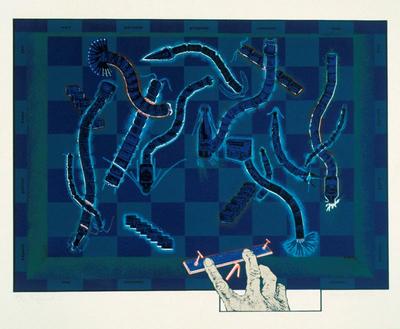Playground III
-
Vivian Lynn
b.1931

Title
Playground III
Details
| Production Date | 1975 |
|---|---|
| Collection(s) | Collection Govett-Brewster Art Gallery, New Plymouth |
| Accession Number | 80/26 |
| Edition | 10/50 |
| Media | Screenprint on paper |
| Measurements | Support: 640 x 905mm |
About
Vivian Lynn, in a career of over 40 years, has consistently produced politically engaged artworks. Ranging across a wide variety of media — from silkscreen prints to sculptures made from human hair — she has been steadfast in her refusal to adopt a ‘signature’ style. Lynn’s attraction to non-traditional materials and processes reflects her understanding of identity as flexible and multiple, but was also part of a deliberate strategy to position herself outside the hierarchical art system of 1960s New Zealand. In her significant Playground series of 1975, Lynn’s use of the mechanical process of silkscreen printing echoes the industrial imagery in the prints.
The title of the Playground series immediately evokes associations of childhood fun. However, in Lynn’s images the word takes on much darker connotations. The bodies populating this nightmarish playground are adults. Naked and genderless, they work the swings and see-saws with mute, exhausted determination. The structures of the playground become the machines of an incarcerating system which simultaneously governs and produces human beings. In Playground IV, the figures on the swings hang in a non-space, diligently swinging as if by their action they are powering some unseen giant machine. Playground VI, which shows human forms subsumed into a ceaselessly rotating system of cogs and wheels, is a direct, passionate statement about human imprisonment in confining social structures.
Each of the Playground works is enclosed by an extra printed border. These frames-within-a-frame function to visually entrap the straining, exhausted bodies in the images, but they also section off these dystopian scenes as a particular ‘view’. The implication is that it is possible to escape, to exist outside the system. By making a feature of the framing of her images, Lynn is declaring her own position in a particular historical time and place, and encouraging her viewers to take a similarly self-aware and critical stance.


